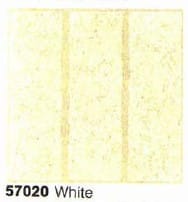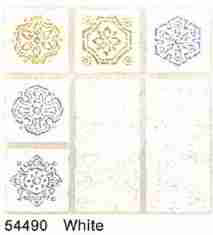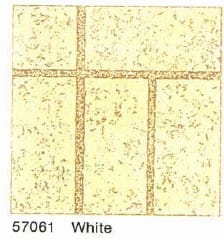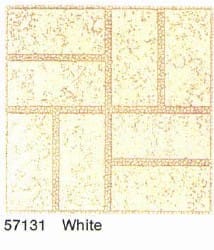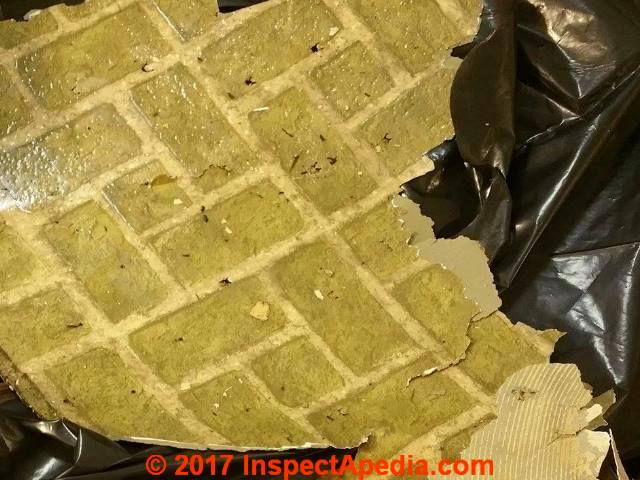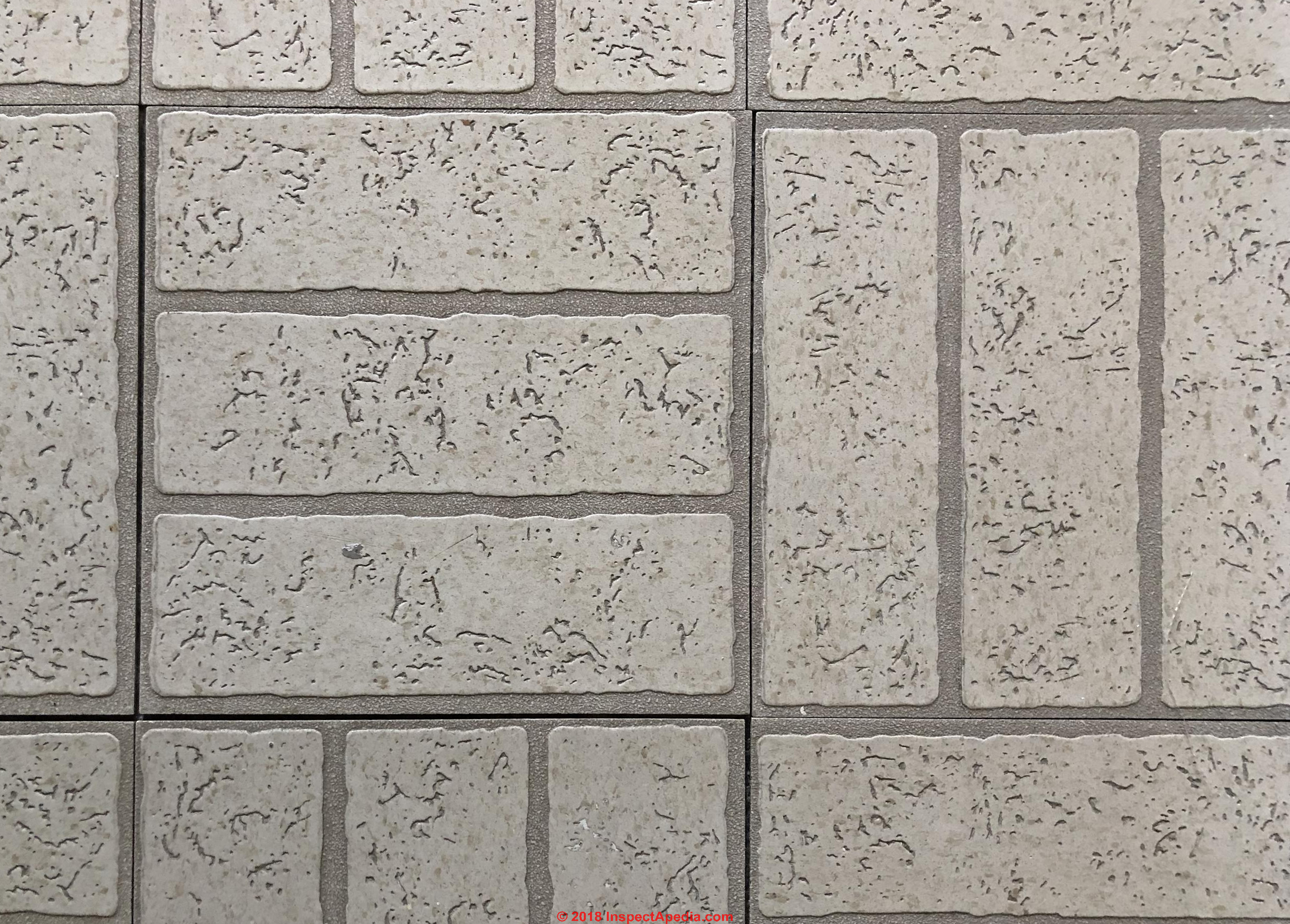 White Brick Pattern Floor Tiles & Sheet Flooring
White Brick Pattern Floor Tiles & Sheet Flooring
that May Contain Asbestos
- POST a QUESTION or COMMENT about white brick pattern sheet flooring products that might contain asbestos
Asbestos-containing floor tile and also sheet flooring or resilient flooring product identification for white brick sheet flooring.
Shown at page top: an Armstrong White Romford-brick floor tile pattern sent to us from a reader whose home was built in 1968.
From the age of the home and the appearance of this white brick pattern flooring it would be reasonable to assume that this floor tile contains asbestos.
This article series describes floor tiles and also sheet flooring, both asbestos-free sheet flooring and sheet flooring products known to contain significant levels of asbestos produced in a white red or golden brick pattern between the 1960's to the late 1980's.
We also include photographs for identification of known asbestos-containing resilient sheet flooring as well as unknown flooring submitted for identification. The article gives safety and asbestos testing advice for sheet flooring products.
InspectAPedia tolerates no conflicts of interest. We have no relationship with advertisers, products, or services discussed at this website.
- Daniel Friedman, Publisher/Editor/Author - See WHO ARE WE?
Armstrong Bradford Brick / Congoleum White Brick Pattern Flooring
In the U.S., Canada, Australia, New Zealand, and the U.K., White brick vinyl-asbestos flooring was sold in various sizes of floor tiles such as 9x9" and12x12" (later) as well as in white brick flooring patterns in sheet flooring products, in various brick layouts including rectangles, half-bricks, and herring-bone patterns.
Photo above: white Bradford Brick sheet flooring is identical in pattern to the white brick floor tile shown at the top of this page.
[Click to enlarge any image]
For illustrations of these same floor tile & sheet flooring patterns in red brick,
see RED BRICK PATTERN SHEET FLOORING
Bottom line: asbestos confirmed in some but not all older sheet flooring of various brick-patterns & brick-colored varied-size rectangle patterns
Several readers report asbestos test lab results confirmed asbestos in several popular brick-pattern sheet flooring installed in North America as well as some other areas before the mid 1980's.
Adding confusion, some reader's tests of identical-looking flooring (reported later in this article) found no asbestos in their sample.
Treat the sheet flooring shown here as PACM - Presumed Asbestos Containing Material - or have a sample of your specific floor tested for asbestos.
That does not mean that occupants of a building where such flooring was installed is in grave danger from airborne asbestos from the flooring.
Where the floor is not glued down, asbestos or not, it can be removed easily with no significant asbestos hazard. Where it's glued down, sheet flooring removal needs to consider minimizing dust and cleaning up properly afterwards. Note too that some floor mastic adhesives also contained asbestos.
When the asbestos-suspect flooring has already been removed but where you are worried about asbestos dust, you can test settled dust or you can simply do more cleaning: damp wiping and HEPA vacuuming.
Photo above: this white Romford Brick sheet flooring in a herring-bone pattern (an Armstrong but not a Solarian product) was sold both as sheet flooring and also as vinyl-asbestos floor tile.
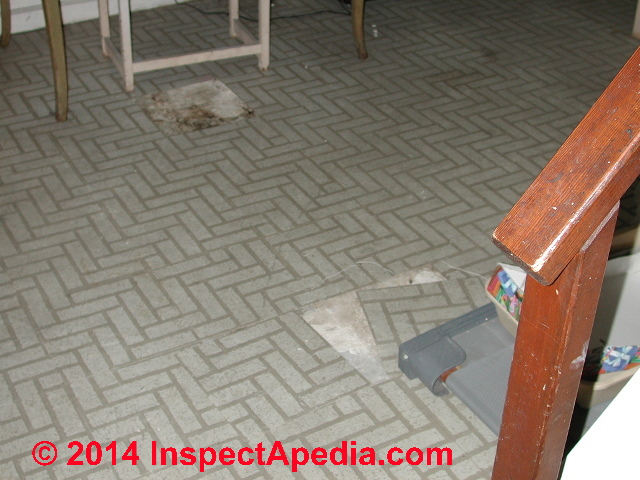 If there is a reason concern for high levels of indoor dust that might be significantly contaminated, for example after an interior demolition job that did not control the spread of dust that might be high in asbestos,
If there is a reason concern for high levels of indoor dust that might be significantly contaminated, for example after an interior demolition job that did not control the spread of dust that might be high in asbestos,
provides a general guide to collecting settled dust to send to a qualified laboratory for analysis.
You'll want to know if significant levels of asbestos or other potentially harmful particles are found in the sample.
This approach, while not giving a quantitative "number" in in fact a more-reliable way to assess a remaining asbestos-dust hazard than an "air test" whose variability error can be several orders of magnitude.
Watch out: that the mastic used to adhere old sheet flooring may also contain asbestos.
Really? Don't panic; non-friable materials like this can usually be handled with a minimum of dust and debris - provided the floor was not glued down;
If you are facing a large cost or have other reasons to be concerned about asbestos contamination in the building it would not be costly to have a small sample of the floor tested.
At the end of this article we include links to information on how to minimize the asbestos hazard from asbestos-suspect sheet flooring or tile flooring.
For white brick pattern floor tile or sheet flooring from the 1970s, one should treat the flooring as presumed to contain asbestos. It would not perhaps be necessary nor appropriate to test something that is easily rolled up and disposed-of, but you'd have wanted to avoid creating a dusty mess.
If you want to test a sample
see ASBESTOS TESTING LAB LIST for help in finding a certified asbestos test lab.
Typically the asbestos test lab fee is around $50. U.S.
Asbestos is found in older floor tile mastic adhesives, particularly the older black asphalt mastics often contained asbestos, as did other similar mastics used in roofing and flashing cements.
See MASTIC, CUTBACK ADHESIVE, FLASHING CEMENT ASBESTOS
Asbestos is found in some (not all) sheet flooring backing materials as well.
It is possible that this popular vinyl asbestos pattern originated in the early 70's as Armstrong's "Romford Red" which is itself an interesting name as I suspect the name leaked over from Rumford - the colonial Tory who fled the colonies back to Britain during the American Revolution.
Rumford was sent to Bavaria where he developed the measurements on the perfect fireplace design - a specification that many red brick fireplaces as of course other fireplaces later followed. A less likely origin of the name is from Romford in Northeast London.
Examples of White Brick Pattern Sheet Flooring Containing Asbestos
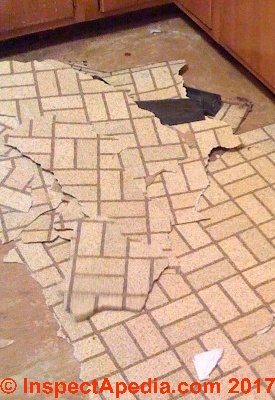
Shown here, a torn-up white Romford Brick-like floor pattern in sheet flooring form.
Brick pattern tile and sheet flooring that look like this were produced at least by Armstrong (under several pattern names I give below) and by Kentile Ken-Flex Flooring.
[Click to enlarge any image]
If your building contains this white brick (or red or green brick) pattern in a floor that was installed before the mid 1980's it would be prudent to treat the floor as PACM or "Presumed Asbestos Containing Material" - not something to panic about, but take care not to make an unnecessary dusty mess.
See ASBESTOS FLOORING HAZARD REDUCTION for detailed guidance.
This white brick pattern sheet flooring photograph was contributed by Anonymous by private email 2017/08/15 who wrote
Based on what I saw when I removed the flooring, which I believe was old asbestos backing, I'm hoping what I removed was a newer version. - Anon.
Below on this page we report on another reader's asbestos test result for this floor pattern.
Shown below, another white brick and half-brick sheet flooring product that may contain asbestos.
This floor pattern was sold both in sheet form and as 12x12 floor tiles.
Index to White Brick Asbestos Floor Tile Layout Patterns
Here are more examples of widely-sold Armstrong vinyl-asbestos floor tiles in brick patterns. Brick pattern tile flooring was sold in both 9x9" and 12x12" versions.
Armstrong CRAFTLON ROMFORD BRICK (9" x 9" 0.80" gauge) pattern vinyl asbestos floor tiles shown above were sold in WHITE 57020, and RED 57021
Craftlon Romford Brick 9" x 9" x 3/32" vinyl asbestos floor tiles were available in White 57020 (above) and in Red 57021 - shown at SHEET & TILE FLOORING ASBESTOS ID-BRICK PATTERN ID. Gold patterns appeared later.
A similar white brick floor tile or sheet flooring pattern added decorations and broke some of the "bricks" into half-bricks, such as Armstrong Craftlon Ranch flooring in Beige, No. 54494.
Also
RANCHO GRANDE GREEN 54492,
and RANCHO GRANDE WHITE 54490, below
Sheet flooring in the brick pattern was popular in both red and white, and may have had its original pattern design in 12" tile format as we document
at 1973 - ARMSTRONG EXCELON VINYL ASBESTOS FLOOR TILES and where we include additional flooring image links
Old Forge White Brick Floor Tile Pattern
Below: Custom Old Forge, another brick floor tile pattern in 12x12" format followed by yet another 12x12 brick pattern, Armstrong Country Brick. This pattern remained identical through at least the 1970s.
Armstrong CUSTOM OLD FORGE 12" x 12" x 1/16" brick pattern floor tiles shown above in WHITE, 57081
White Country Brick Floor Tile Pattern
COUNTRY BRICK 12" x 12" regular brick pattern Armstrong vinyl asbestos floor tiles sold in these colors: TERRA COTTA 57400, WHITE 57401, BURNT TOAST, 57402, above and especially recommended for kitchens, ALMOND 57403)
Custom Glenmore White Brick Floor Tile Pattern
Armstrong CUSTOM GLENMORE BRICK 12" x 12" and CUSTOM OLD FORGE 12" x 12" x 1/16" thick floor tiles, shown in above.
White Brick Pattern Vinyl Asbestos Floor Tile & Sheet Flooring Test Results
Follow-up: positive asbestos content of a white brick pattern vinyl sheet flooring and asbestos in the black mastic
I did have it tested locally at accredited lab. They found asbestos in the top red-grey-black brick vinyl layer AND in the black mastic. (BUT amazingly, NOT in the grey mastic or the paper-felt backing) Feel free to add that red brick sheet vinyl to the list of 'known' asbestos.
Feel free to add that red brick sheet vinyl to the list of 'known' asbestos.
Thanks, R.
Reply:
Thanks R.D. You can see more brick pattern asbestos floor coverings that contained asbestos in a tile form that is very similar to the red brick sheet flooring in your photos. Both were very popular.
More white brick flooring pattern photographs
This brick-like floor pattern was sold
in both tile and sheet flooring forms
in several colors including red, white, gray, green
See ARMSTRONG FLOOR TILE IDENTIFICATION 1974-1979 for more images of brick pattern asbestos containing flooring like the white brick Armstrong flooring shown at above-left.
More brick pattern flooring ID photos from this era are at
- Excelon floor tiles in pattern: CUSTOM OLD FORGE 12" x 12" x 1/16" (White, 57081)
Don't confuse this with CUSTOM GLENMORE BRICK 12" x 12" x 1/16" and also distinguish it from or ROMFORD BRICK floor tiles from (example year) 1973. - Also see our BRICK FLOOR PATTERN PHOTOS from 1978 where we show both tile and a continuous sheet resilient flooring product that also used the Romford Brick floor pattern.
Reader comment: this light Olive-Green Brick Pattern vinyl sheet flooring from 1969-1971 tested positive for asbestos
I wanted to add to your photo guide - this light olive-green & white brick pattern sheet flooring with a white backer tested positive for asbestos. It's original to the house, which was built between 1969 and 1971. - C.B. 2017/04/23
Reader follow-up - no asbestos in the vinyl sheet flooring, black felt backing, or mastic.
Good news! There was not any asbestos in the vinyl sheet flooring, black felt backing, or mastic.
[Click to enlarge any image]
...
Reader Comments, Questions & Answers About The Article Above
Below you will find questions and answers previously posted on this page at its page bottom reader comment box.
Reader Q&A - also see RECOMMENDED ARTICLES & FAQs
Question: worried that our 1970s white brick pattern sheet flooring contained asbestos
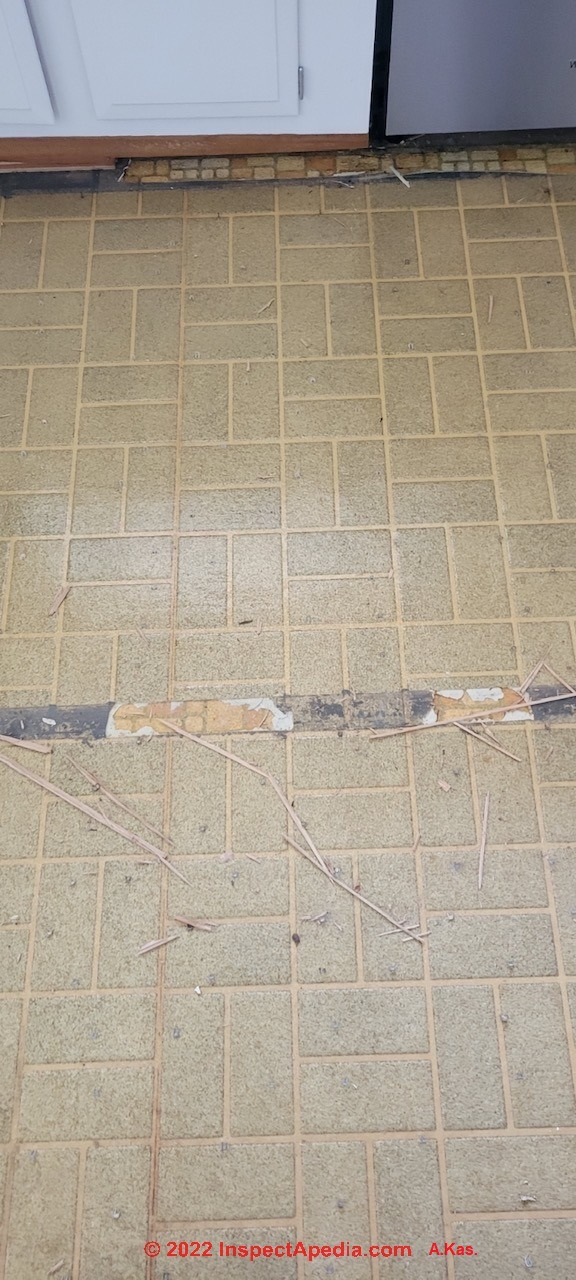 We recently had service pro, contracted through Lowes, install new flooring. Our house was built in 1974/1975.
We recently had service pro, contracted through Lowes, install new flooring. Our house was built in 1974/1975.
They removed two layers of linoleum flooring without testing first. We were in the house when the removal took place. They were only supposed to remove the top layer but went ahead and removed both layers.
I am extremely worried that the flooring contained asbestos. Please see the attached photo which shows both flooring patterns . Is there anyway to determine if this contained asbestos without a sample.
I am worried for my family. Thank you for looking at this photo. I did search your photos on your website to see if I could find our patterns. - Anonymous by private email - 2022/05/30
Moderator reply: 1970s white brick pattern sheet flooring backer likely to contain asbestos
a search of InspectApedia.com for "white brick pattern flooring" finds that floor discussed at
SHEET & TILE FLOORING BRICK PATTERN ID - https://inspectapedia.com/hazmat/Brick_Pattern_Sheet_Flooring_Identification.php
What matters is the thoroughness of dust control and dust or debris clean-up
You can elect to do further cleaning as I suggested before, or you can go to a location where there is settled dust that hasn't been cleaned such as the trim over a window or door and have that tested to see if there was a notable level of asbestos in any remaining dust. If you found that were the case that you would do additional cleaning.
See details at
Reader follow-up: demolition done without dust control and without cleanup
Thank you. There was no control and we cleaned up after they were finished.
Moderator reply: damp wipe, HEPA vacuum, or quit.
If flooring could be rolled up, if there wasn't much chopping, grinding, sawing, dust, then the risk of hazardous dust would be much much less.
A homeowner DIY cleanup job, done without proper equipment and methods, may not be effective.
If in doubt, HEPA vacuum and damp wipe surfaces.
Reader follow-up: would a HEPA vacuum help.
They had to chisel it up. The floor was removed a month ago. At this point would a HEPA vacuum be of any help?
I did vacuum mop and wipe all surfaces when they finished but it was a 2 day job. The supervisor said the flooring patterns weren’t asbestos patterns but I don’t know how they could know indefinitely without testing :/
Also, thank you for your quick responses.
I did wet mop all of the floors
Is there anything at this point a month past, with new flooring down that we should/can do?
Moderator reply: non-HEPA vacuums spread small dust particles
If you used a conventional household vacuum cleaner to vacuum asbestos laid in dust then you aerated those articles throughout the building. If that's the case, then to properly clean up you would need to damp wipe and use HEPA vacuuming.
You can elect to do further cleaning as I suggested before, or as I have suggested, you can go to a location where there is settled dust that hasn't been cleaned such as the trim over a window or door and have that tested to see if there was a notable level of asbestos in any remaining dust. If you found that were the case that you would do additional cleaning.
If you want to read details and be more-informed about these procedures, see
On 2021-01-01 by (mod) - asbestos in flooring in bad shape?
For flooring that is in poor condition, either test that flooring or treat it as presumed to contain asbestos
On 2020-05-26 by Rod - Asbestos or not asbestos? Early 1980's remodel job white brick pattern flooring
Asbestos or no asbestos? Early 80’s remodel?!
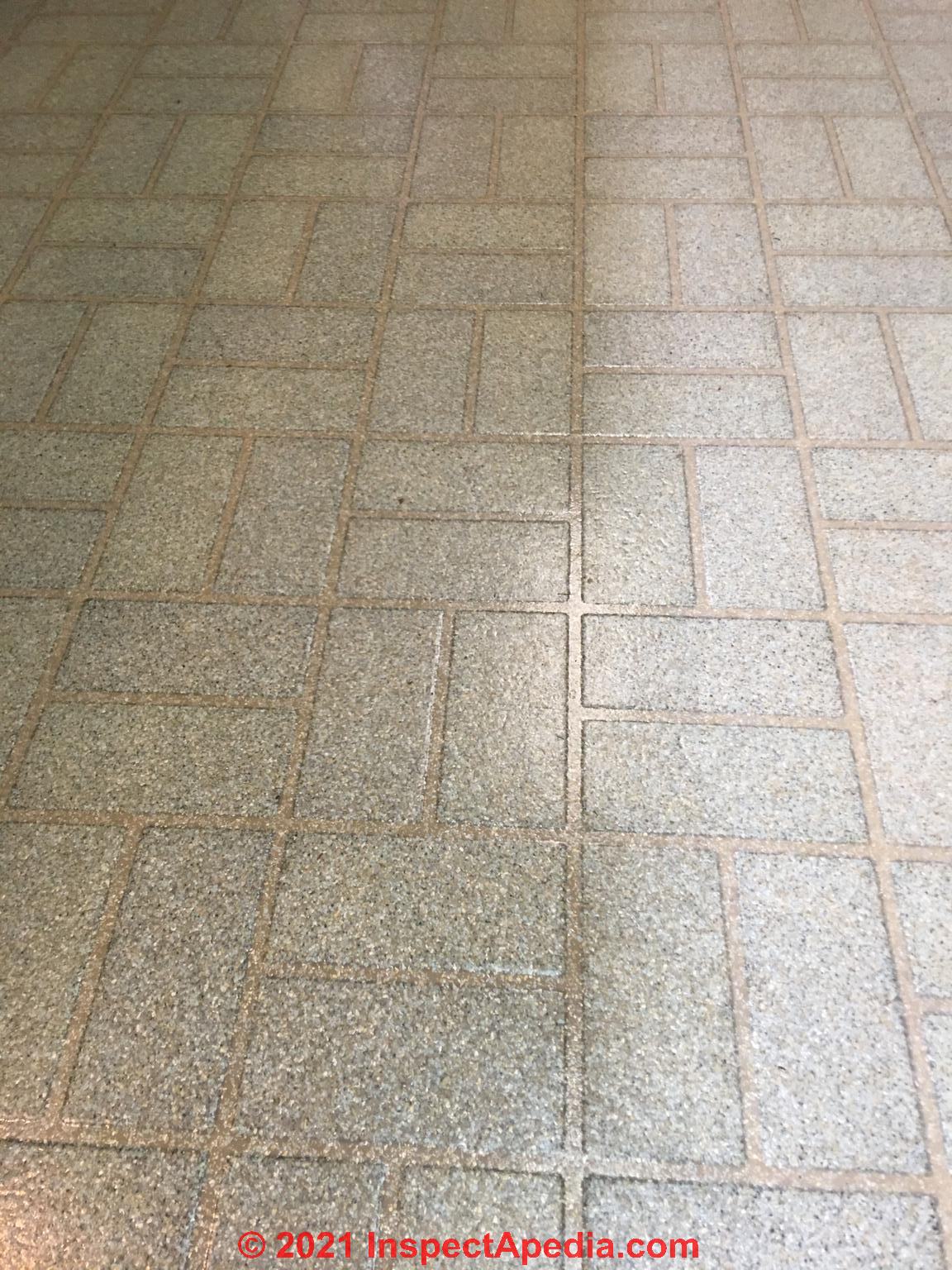
On 2020-05-27 - by (mod) - asbestos likely in early 1980s white brick sheet flooring
Early 80s white brick pattern vinyl sheet flooring: yes that's likely to contain asbestos
Details of things you can do to reduce the hazard are
On 2020-01-21 by Drew - White brick pattern flooring in 1963 home: poor condition
This flooring is under existing carpet and is worn/damaged in places. We want to remove it & replace with ceramic tile but uncertain if contains asbestos. Our house dates from 1963 and this is probably original.It's on top of concrete base. Any help greatly appreciated.

On 2020-01-21 - by (mod) -
Drew,
With the apology that no visual check is conclusive (as would be an asbestos test lab result), I have certainly seen that floor pattern as one containing asbestos in homes of the age you cite.
DOES THIS FLOORING CONTAIN ASBESTOS? https://inspectapedia.com/hazmat/DIY-Asbestos-Floor-Test.php
gives some practical things to ask that can help improve the answer
On 2019-12-15 by Carter - White brick pattern flooring with brown fiber backing
Does this look like asbestos vinyl sheet flooring the back looks like a brown fiber?

On 2019-12-15 - by (mod) -
It is possible, Carter; there were vinyl asbestos sheet and tile flooring products with that pattern.
Take care: that flooring looks quite brittle. If you cannot cover it over in place see ASBESTOS FLOORING REMOVAL GUIDE https://inspectapedia.com/hazmat/Asbestos-Floor-Removal.php
Short of testing a sample you can also see the easy questions at DOES THIS FLOORING CONTAIN ASBESTOS? https://inspectapedia.com/hazmat/DIY-Asbestos-Floor-Test.php
On 2019-07-23 by Terry - Does 1986 Armstrong Glenmore brick contain asbestos?
Does Armstrong pattern Glenmore brick installed in a house built in 1986 contain asbestos
On 2019-07-23 by (mod) -
Quite possibly. Unfortunately that year is right around the time companies stopped using asbestos so if you have to make a dusty mess of your floor (better to leave it alone and cover it over) you'll want to test a sample.
If you decide to do so let me know what you find. Any photos can be helpful, especially if you find any packaging for your floor.
On 2019-01-13 by Kate - is it ok to simply cover our assumed-asbestos sheet vinyl with new underlayment and a new hardwood floor?
We’re prepping to install solid hardwoods in our 1963 house in Maryland. We found this brick pattern under the carpet padding in one room. It appears that there are three layers in some rooms (as you can see how the previous owner tiled over all these layers in the photo).
I can’t find it anywhere on your site. It’s definitely a sheet product, and looks to be in good shape, from the small areas we can see, but we haven’t tried messing with it yet.
The other pic is at a floor vent in the next room, with solid hardwood, floated over two layers of newer vinyl over an original layer I think. 3/4” plywood below. Do you know this brick pattern and if it contains asbestos? We’re worried because we already bought nail-down solid hardwoods for this project!
Would it be safe to nail them down with a paper underlayment in between?
So given the 1963 date on the house, I guess we should assume asbestos to be safe.
I guess the bigger question is, if we put an underlayment between the sheet vinyl (nonfriable) and the new hardwoods, is nailing the T&G hardwood over top considered ok, since we won’t be sanding or grinding the presumed asbestos floor?
My husband is trying to convince me it is, but I find a wide range of opinions on it when I search! Any help would be greatly appreciated! I will add, we have two young kids in the house. Thanks!
On 2019-01-13 by (mod) - generally yes
Kate
That sounds entirely reasonable to me.
On 2018-10-08 by Ben - Anderson brick pattern flooring - is there asbestos glue?
Found this flooring under 2 layers of laminate wood, on top of an original wood floor. Has some of the Anderson brick pattern, but the underneath doesn’t look like what I’ve read to be asbestos glue. Though the age and look indicates it may have.
IMAGE LOST by older version of Comments code - now fixed. Please re-post the image if you can. Sorry. Mod.
On 2018-10-08 by (mod) - Both black asphalt-type tile mastic and lighter colored adhesives used up to the early 1980's may contain asbestos.
Ben
Both black asphalt-type tile mastic and lighter colored adhesives used up to the early 1980's may contain asbestos.
...
Continue reading at ASBESTOS FLOORING HAZARD REDUCTION or select a topic from the closely-related articles below, or see the complete ARTICLE INDEX.
Or see these
Recommended Articles
- ASBESTOS FLOOR TILE LAB PROCEDURES - gives bit of background on how a lab might test actual flooring samples.
- ASBESTOS FLOORING HAZARD REDUCTION
- ASBESTOS FLOORING REMOVAL GUIDE
- ASBESTOS TEST RESULTS for TILE & SHEET FLOORING
- ASBESTOS TESTING LAB LIST if you are faced with a costly, messy demolition of asbestos-suspect sheet or tile flooring
- DOES THIS MATERIAL CONTAIN ASBESTOS? - 5 easy questions to tell if a BUILDING MATERIAL probably contains asbestos -
- DUST / MOLD TEST KIT INSTRUCTIONS gives details on how to collect a dust sample using clear adhesive tape: low cost and easy.
- RESILIENT SHEET FLOORING ID GUIDE
- SHEET & TILE FLOORING ASBESTOS ID-BRICK PATTERN ID
- SHEET FLOORING INSPECT / TEST
- WHITE ASBESTOS FLOOR TILE IDENTIFICATION
- WHITE SHIELD® BACKING ASBESTOS in FLOORING
Suggested citation for this web page
SHEET & TILE FLOORING ASBESTOS ID-WHITE BRICK at InspectApedia.com - online encyclopedia of building & environmental inspection, testing, diagnosis, repair, & problem prevention advice or see this topic index:
INDEX to RELATED ARTICLES: ARTICLE INDEX to ASBESTOS HAZARDS
Or use the SEARCH BOX found below to Ask a Question or Search InspectApedia
Ask a Question or Search InspectApedia
Try the search box just below, or if you prefer, post a question or comment in the Comments box below and we will respond promptly.
Search the InspectApedia website
Note: appearance of your Comment below may be delayed: if your comment contains an image, photograph, web link, or text that looks to the software as if it might be a web link, your posting will appear after it has been approved by a moderator. Apologies for the delay.
Only one image can be added per comment but you can post as many comments, and therefore images, as you like.
You will not receive a notification when a response to your question has been posted.
Please bookmark this page to make it easy for you to check back for our response.
IF above you see "Comment Form is loading comments..." then COMMENT BOX - countable.ca / bawkbox.com IS NOT WORKING.
In any case you are welcome to send an email directly to us at InspectApedia.com at editor@inspectApedia.com
We'll reply to you directly. Please help us help you by noting, in your email, the URL of the InspectApedia page where you wanted to comment.
Citations & References
In addition to any citations in the article above, a full list is available on request.
- Richa Wilson, Kathleen Snodgrass, " EARLY 20TH-CENTURY BUILDING MATERIALS: RESILIENT FLOORING " [Very large PDF], Richa Wilson, Intermountain Regional Architectural Historian Kathleen Snodgrass, Project Leader, United States Department of Agriculture Forest Service, Technology & Development Program, August 2007, 7300-0773-2322-MTDC. Contact Kathie Snodgrass at MTDC: Tel: 406–329–3922, Email: ksnodgrass@fs.fed.us or Richa Wilson, author; USDA Forest Service, Intermountain Region, 324 25th Street, Ogden, UT 84401. Phone: 801–625–5704; fax: 801–625–5229: e-mail: rwilson@fs.fed.us
- In addition to citations & references found in this article, see the research citations given at the end of the related articles found at our suggested
CONTINUE READING or RECOMMENDED ARTICLES.
- Carson, Dunlop & Associates Ltd., 120 Carlton Street Suite 407, Toronto ON M5A 4K2. Tel: (416) 964-9415 1-800-268-7070 Email: info@carsondunlop.com. Alan Carson is a past president of ASHI, the American Society of Home Inspectors.
Thanks to Alan Carson and Bob Dunlop, for permission for InspectAPedia to use text excerpts from The HOME REFERENCE BOOK - the Encyclopedia of Homes and to use illustrations from The ILLUSTRATED HOME .
Carson Dunlop Associates provides extensive home inspection education and report writing material. In gratitude we provide links to tsome Carson Dunlop Associates products and services.




